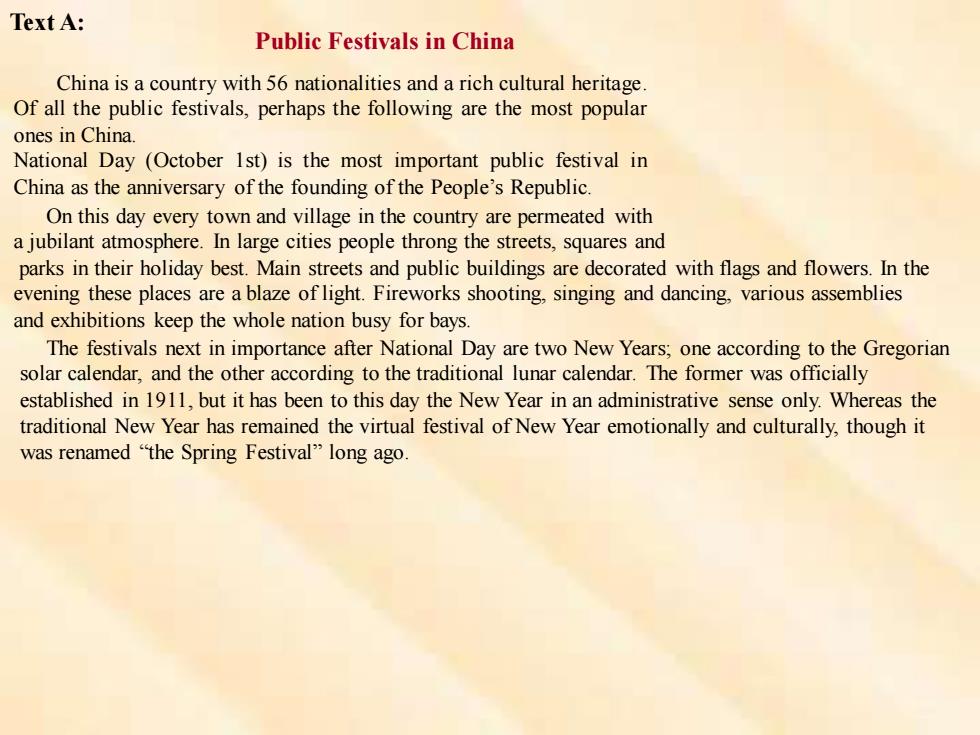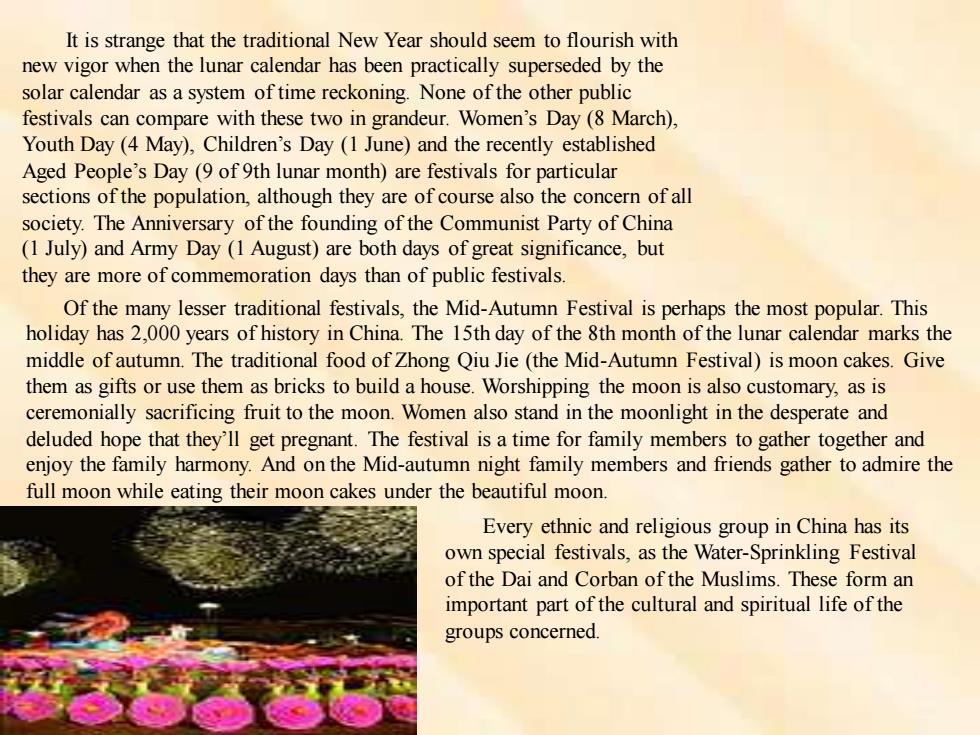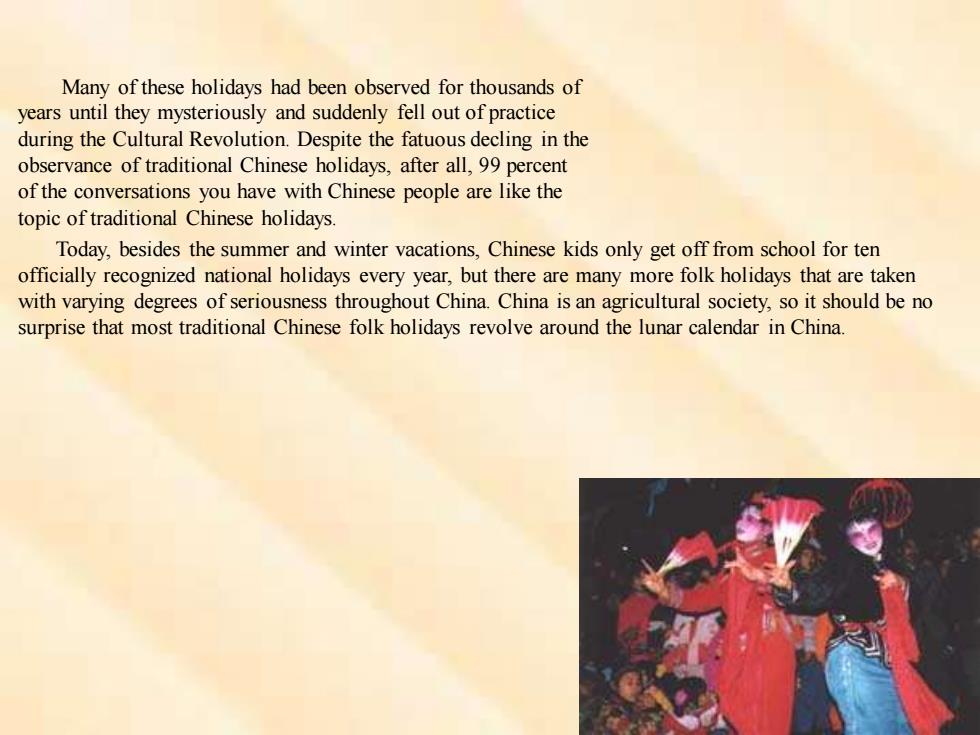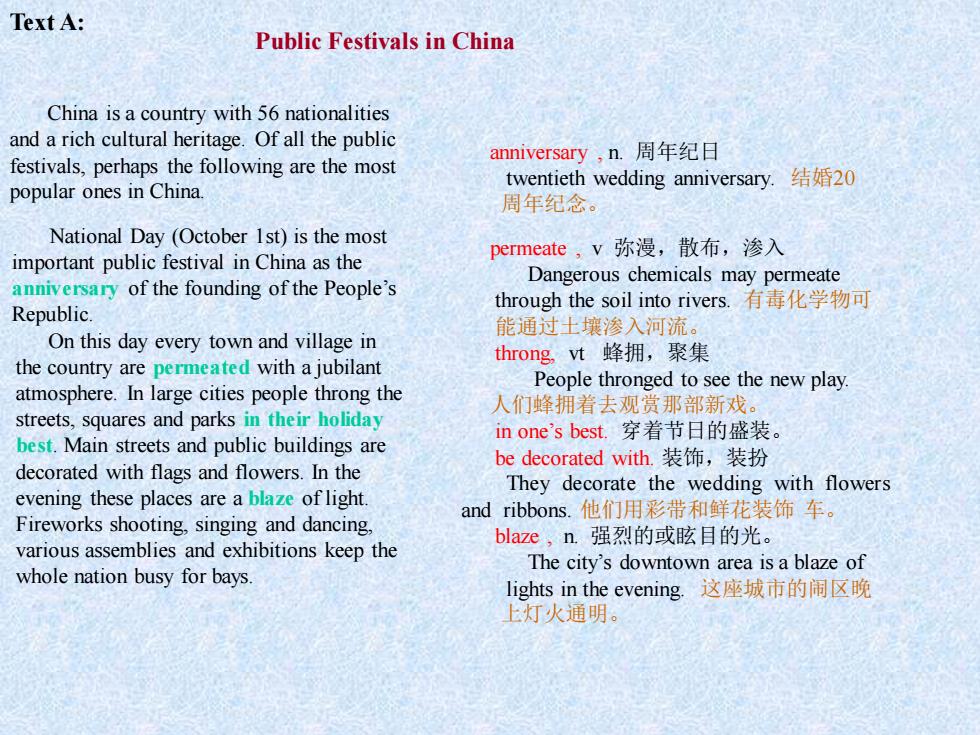
Text A: Public Festivals in China China is a country with 56 nationalities and a rich cultural heritage. Of all the public festivals,perhaps the following are the most popular ones in China. National Day (October Ist)is the most important public festival in China as the anniversary of the founding of the People's Republic. On this day every town and village in the country are permeated with a jubilant atmosphere.In large cities people throng the streets,squares and parks in their holiday best.Main streets and public buildings are decorated with flags and flowers.In the evening these places are a blaze of light.Fireworks shooting,singing and dancing,various assemblies and exhibitions keep the whole nation busy for bays. The festivals next in importance after National Day are two New Years;one according to the Gregorian solar calendar,and the other according to the traditional lunar calendar.The former was officially established in 1911,but it has been to this day the New Year in an administrative sense only.Whereas the traditional New Year has remained the virtual festival of New Year emotionally and culturally,though it was renamed "the Spring Festival"long ago
Text A: Public Festivals in China China is a country with 56 nationalities and a rich cultural heritage. Of all the public festivals, perhaps the following are the most popular ones in China. National Day (October 1st) is the most important public festival in China as the anniversary of the founding of the People’s Republic. On this day every town and village in the country are permeated with a jubilant atmosphere. In large cities people throng the streets, squares and parks in their holiday best. Main streets and public buildings are decorated with flags and flowers. In the evening these places are a blaze of light. Fireworks shooting, singing and dancing, various assemblies and exhibitions keep the whole nation busy for bays. The festivals next in importance after National Day are two New Years; one according to the Gregorian solar calendar, and the other according to the traditional lunar calendar. The former was officially established in 1911, but it has been to this day the New Year in an administrative sense only. Whereas the traditional New Year has remained the virtual festival of New Year emotionally and culturally, though it was renamed “the Spring Festival” long ago

The solar New Year is quite eclipsed by the traditional New Year both in importance and festivity.On this one-day national holiday there is little of what you would call rousing celebrations.It is an occasion for presenting new stage,screen or TV shows,and a convenient day for holding a wedding.Otherwise it is just an ordinary holiday.For many it is no more than an extra Sunday. The lunar New Year(the Spring Festival )is the festival of festivals,which is deep-rooted in the life and soul of hundreds of hundreds of millions of people.It is a time of family reunion,good whishes,thanksgiving, new promises,hopes for the future,and merrymaking.Although officially there are only three full days,the celebrations of the Spring Festival take place in late January or early February and last for nearly a month, beginning ten days before the end of the year and extending well past the middle of the first month of the new year.The historical reason for beginning the year during cold weather is that it is a time between the"autumn harvest and winter storage"and"spring plowing and summer weeding."In other words,this is the time for rest and relaxation after a year's toil,and for celebration as well. The festivities reach their climax around the New Year's Eve and the New Year's Day,when there are continuous feasting and rejoicing amid the din of gong striking,drum beating and firecracker shooting.While the grown-ups occupy themselves with New Year dinner parties and mutual calls,the children enjoy the New Year entertainment such as fireworks and lantern displays,lion dance and entertainment such as fireworks and lantern displays,lion dance and other folk shows visits to festival fairs,etc.Nothing is spared to make the celebrations joyous and memorable
The solar New Year is quite eclipsed by the traditional New Year both in importance and festivity. On this one-day national holiday there is little of what you would call rousing celebrations. It is an occasion for presenting new stage, screen or TV shows, and a convenient day for holding a wedding. Otherwise it is just an ordinary holiday. For many it is no more than an extra Sunday. The lunar New Year (the Spring Festival ) is the festival of festivals, which is deep-rooted in the life and soul of hundreds of hundreds of millions of people. It is a time of family reunion, good whishes, thanksgiving, new promises, hopes for the future, and merrymaking. Although officially there are only three full days, the celebrations of the Spring Festival take place in late January or early February and last for nearly a month, beginning ten days before the end of the year and extending well past the middle of the first month of the new year. The historical reason for beginning the year during cold weather is that it is a time between the “autumn harvest and winter storage” and “spring plowing and summer weeding.” In other words, this is the time for rest and relaxation after a year’s toil, and for celebration as well. The festivities reach their climax around the New Year’s Eve and the New Year’s Day, when there are continuous feasting and rejoicing amid the din of gong striking, drum beating and firecracker shooting. While the grown-ups occupy themselves with New Year dinner parties and mutual calls, the children enjoy the New Year entertainment such as fireworks and lantern displays, lion dance and entertainment such as fireworks and lantern displays, lion dance and other folk shows visits to festival fairs, etc. Nothing is spared to make the celebrations joyous and memorable

It is strange that the traditional New Year should seem to flourish with new vigor when the lunar calendar has been practically superseded by the solar calendar as a system of time reckoning.None of the other public festivals can compare with these two in grandeur.Women's Day(8 March), Youth Day(4 May),Children's Day(1 June)and the recently established Aged People's Day (9 of 9th lunar month)are festivals for particular sections of the population,although they are of course also the concern of all society.The Anniversary of the founding of the Communist Party of China (1 July)and Army Day (1 August)are both days of great significance,but they are more of commemoration days than of public festivals. Of the many lesser traditional festivals,the Mid-Autumn Festival is perhaps the most popular.This holiday has 2,000 years of history in China.The 15th day of the 8th month of the lunar calendar marks the middle of autumn.The traditional food of Zhong Qiu Jie(the Mid-Autumn Festival)is moon cakes.Give them as gifts or use them as bricks to build a house.Worshipping the moon is also customary,as is ceremonially sacrificing fruit to the moon.Women also stand in the moonlight in the desperate and deluded hope that they'll get pregnant.The festival is a time for family members to gather together and enjoy the family harmony.And on the Mid-autumn night family members and friends gather to admire the full moon while eating their moon cakes under the beautiful moon. Every ethnic and religious group in China has its own special festivals,as the Water-Sprinkling Festival of the Dai and Corban of the Muslims.These form an important part of the cultural and spiritual life of the groups concerned
It is strange that the traditional New Year should seem to flourish with new vigor when the lunar calendar has been practically superseded by the solar calendar as a system of time reckoning. None of the other public festivals can compare with these two in grandeur. Women’s Day (8 March), Youth Day (4 May), Children’s Day (1 June) and the recently established Aged People’s Day (9 of 9th lunar month) are festivals for particular sections of the population, although they are of course also the concern of all society. The Anniversary of the founding of the Communist Party of China (1 July) and Army Day (1 August) are both days of great significance, but they are more of commemoration days than of public festivals. Of the many lesser traditional festivals, the Mid-Autumn Festival is perhaps the most popular. This holiday has 2,000 years of history in China. The 15th day of the 8th month of the lunar calendar marks the middle of autumn. The traditional food of Zhong Qiu Jie (the Mid-Autumn Festival) is moon cakes. Give them as gifts or use them as bricks to build a house. Worshipping the moon is also customary, as is ceremonially sacrificing fruit to the moon. Women also stand in the moonlight in the desperate and deluded hope that they’ll get pregnant. The festival is a time for family members to gather together and enjoy the family harmony. And on the Mid-autumn night family members and friends gather to admire the full moon while eating their moon cakes under the beautiful moon. Every ethnic and religious group in China has its own special festivals, as the Water-Sprinkling Festival of the Dai and Corban of the Muslims. These form an important part of the cultural and spiritual life of the groups concerned

Many of these holidays had been observed for thousands of years until they mysteriously and suddenly fell out of practice during the Cultural Revolution.Despite the fatuous decling in the observance of traditional Chinese holidays,after all,99 percent of the conversations you have with Chinese people are like the topic of traditional Chinese holidays. Today,besides the summer and winter vacations,Chinese kids only get off from school for ten officially recognized national holidays every year,but there are many more folk holidays that are taken with varying degrees of seriousness throughout China.China is an agricultural society,so it should be no surprise that most traditional Chinese folk holidays revolve around the lunar calendar in China
Many of these holidays had been observed for thousands of years until they mysteriously and suddenly fell out of practice during the Cultural Revolution. Despite the fatuous decling in the observance of traditional Chinese holidays, after all, 99 percent of the conversations you have with Chinese people are like the topic of traditional Chinese holidays. Today, besides the summer and winter vacations, Chinese kids only get off from school for ten officially recognized national holidays every year, but there are many more folk holidays that are taken with varying degrees of seriousness throughout China. China is an agricultural society, so it should be no surprise that most traditional Chinese folk holidays revolve around the lunar calendar in China

TextA: Public Festivals in China China is a country with 56 nationalities and a rich cultural heritage.Of all the public festivals,perhaps the following are the most anniversary,n.周年纪日 twentieth wedding anniversary. 结婚20 popular ones in China. 周年纪念。 National Day (October Ist)is the most important public festival in China as the permeate,v弥漫,散布,渗入 anniversary of the founding of the People's Dangerous chemicals may permeate Republic. through the soil into rivers.有毒化学物可 能通过士壤渗入河流。 On this day every town and village in the country are permeated with a jubilant throng,vt蜂拥,聚集 atmosphere.In large cities people throng the People thronged to see the new play 人们蜂拥着去观赏那部新戏。 streets,squares and parks in their holiday in one's best..穿着节日的盛装。 best.Main streets and public buildings are be decorated with.装饰,装扮 decorated with flags and flowers.In the They decorate the wedding with flowers evening these places are a blaze of light. and ribbons.他们用彩带和鲜花装饰车。 Fireworks shooting,singing and dancing. various assemblies and exhibitions keep the blaze,n强烈的或眩目的光。 The city's downtown area is a blaze of whole nation busy for bays lights in the evening.这座城市的闹区晚 上灯火通明
Text A: Public Festivals in China China is a country with 56 nationalities and a rich cultural heritage. Of all the public festivals, perhaps the following are the most popular ones in China. National Day (October 1st) is the most important public festival in China as the anniversary of the founding of the People’s Republic. On this day every town and village in the country are permeated with a jubilant atmosphere. In large cities people throng the streets, squares and parks in their holiday best. Main streets and public buildings are decorated with flags and flowers. In the evening these places are a blaze of light. Fireworks shooting, singing and dancing, various assemblies and exhibitions keep the whole nation busy for bays. anniversary , n. 周年纪日 twentieth wedding anniversary. 结婚20 周年纪念。 permeate , v 弥漫,散布,渗入 Dangerous chemicals may permeate through the soil into rivers. 有毒化学物可 能通过土壤渗入河流。 throng, vt 蜂拥,聚集 People thronged to see the new play. 人们蜂拥着去观赏那部新戏。 in one’s best. 穿着节日的盛装。 be decorated with. 装饰,装扮 They decorate the wedding with flowers and ribbons. 他们用彩带和鲜花装饰 车。 blaze , n. 强烈的或眩目的光。 The city’s downtown area is a blaze of lights in the evening. 这座城市的闹区晚 上灯火通明